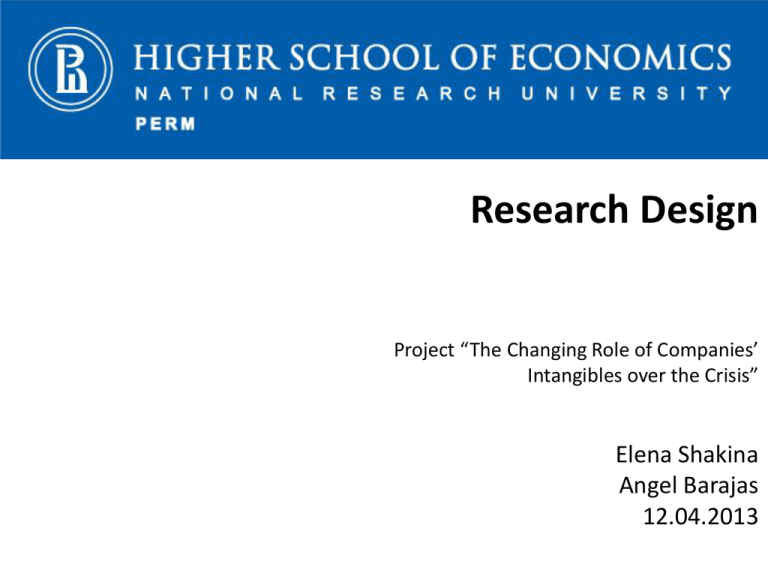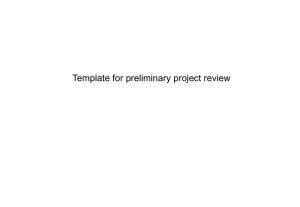Research Design Project *The Changing Role of Companies
advertisement

Research Design Project “The Changing Role of Companies’ Intangibles over the Crisis” Elena Shakina Angel Barajas 12.04.2013 The Aim of the Discussion To have a common understanding of the key outlines of our study To draw a core specification of the empirical analysis To agree on terms and methodology To identify the common framework of our study The Framework of our Study We learn more about the value creation process on turbulent markets Considering a positive economic profit as a condition of value creation Examining intangibles on key value drivers Establishing critical impact of exogenous economic shocks (crises) on companies’ value drivers Research Framework: EVA concept NOPAT Capital Charge EVA Invested Capital WACC – alternative costs of invested capital EVA ROIC WACC WACC ROIC industry Research Framework: MVA concept Market Value (Equity + Debt) EVA3 Invested Capital EVA2 Market Value Added EVA1 n EVAi å (1+ WACC) i=1 i Research Framework: Value creation EVA & MVA Value Creation as a management goal to meet requirements of investors (Steward, Stern, Copeland, Koller, O’Byrne etc ) Investors are looking for companies with positive (or increasing) EVA and providing a growth of MVA Economic profit (or EVA) is an indicator of companies performance which shows if a particular company succeeds covering alternative costs of its investors Market value added is an outcome of investors estimations (expectations) regarding companies’ future – investment attractiveness Research Framework: Specifying value creation process input • Companies resources Investment decisions made by companies’ managers: • to invest in resources which provide competitive advantages output outcome • EVA Positive and increasing EVA • is a goal of managers • is a signal for investors to buy • MVA Shows that companies value drivers were recognized by investors 1 Exploration of EVA drivers (managers’ view) 2 Exploration of MVA drivers (investors’ view) “Production function” Exploration EVA as an indicator of investment attractiveness Research Framework: Specifying crisis impact Value creation process Inputs (Intangibles) Outcome: MVA Output: EVA (competitive advantages ) (outcome of investment attractiveness) Key assumption by affecting market conditions and investors’ expectations Value creation process and value drivers are likely to be changed across crisis periods Economic crisis which influences a value creation process Research Framework: Value Drivers of EVA &MVA EVA is associated with companies’ intangibles which provide competitive advantages MVA is associated with companies’ intangibles which are treated by investors as growth enhancers the quality of human resources, social capital top-management qualification and expertise Relational Capital the efficiency of relations with companies customers, suppliers, partners, investors marketing network, contracts, brands, reputation Innovative Capital innovative activities intellectual property, new products Structural Capital internal business processes quality management system Human Capital Research Methodology Hypothetico-deductive reasoning basing on theory and practical experience the hypotheses are put forward Quantitative analysis Quasi-naturalistic observations Information is taken from companies annual reports, financial markets, rankings, information bureau, websites Methodology: how to measure Intangibles Most of the intangibles have no direct estimation • Proxy indicators provide a solution Asking companies’ representatives • High degree of subjectivity • deep understanding of respondents • Much data available Collecting data from public available sources (by involving few experts) • Restricted information and data available • Estimations are less biased and more objective Methodology: proxy indicators The scale might be wrong but if we apply it for all observations, at least we are able to compare them conducting statistical analysis Proxy indicators have to be validated for each particular case! Ways to do that… Examples: • ‘board of directors’ qualification’ is used as a proxy indicator for the quality of all human resources as expected to have a positive correlation with the qualification of the staff hired • ‘owners/directors ratio’ is used as a proxy indicator for principal-agent conflict as a probability of a principal-agent conflict is rising with the decreasing involvement of investors (shareholders) in corporate management Methodology: tools Specification & Econometric tools to establish causality (avoiding endogeneity) to estimate statistically significant relation to conduct the analysis of the estimated functions Specification Estimation tools • linear relation • framework of CES production function • panel data analysis • structural equations modeling • hierarchical multiple regression Methodology: econometric specification Inputs Output/outcome Control variables to make an accurate estimation non significant factors can be skipped • Every specification has to take into account: • all value drivers (theoretically established) • control variables related to country, industry, period Research Questions Intangible drivers of companies’ competitive advantages expressed in EVA (industry benchmark) Comparative study of different time periods: before, during and after the economic crisis Intangible drivers of companies’ investment attractiveness expressed in MVA Transformation of companies’ competitive advantages into investment attractiveness (external and internal drivers) Comparative study of different European markets: UK+Germany+France (prosperous economy) and Spain+Italy (protracted economic crisis) Comparative study of different industries: traditional vs. innovative, production vs. services, high concentrated vs. industries with high competition … Examples of the Hypotheses have to based either on failure of theory or on contradiction faced in the empirical studies The more flexible the company was (in terms of changing investment strategy) the better its chances of survival during the crisis The return to scale of intangibles employment changes across the prosperity, crises and recovery periods Traditional industries were less influenced by the crisis shocks in relation to innovative ones International penetration of UK and Germany companies provided them with the survival support during the recovery period





